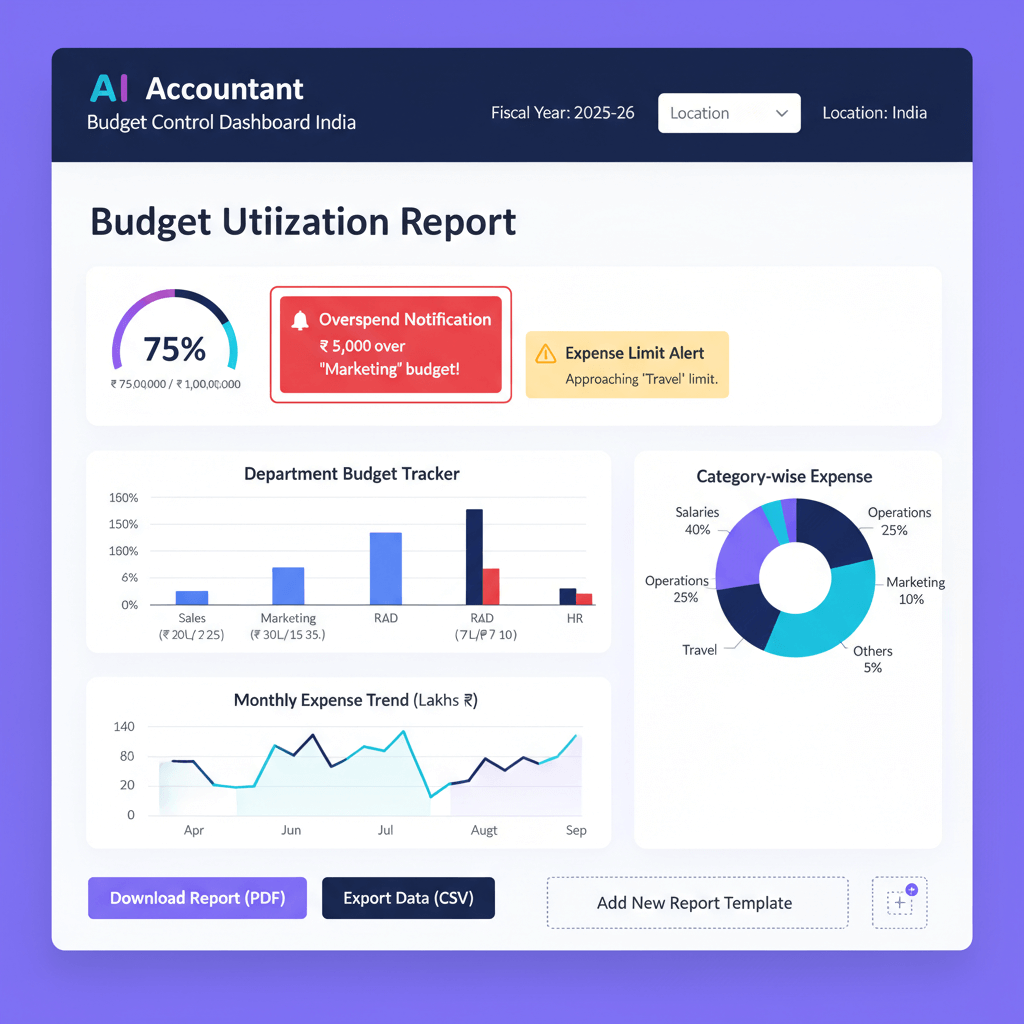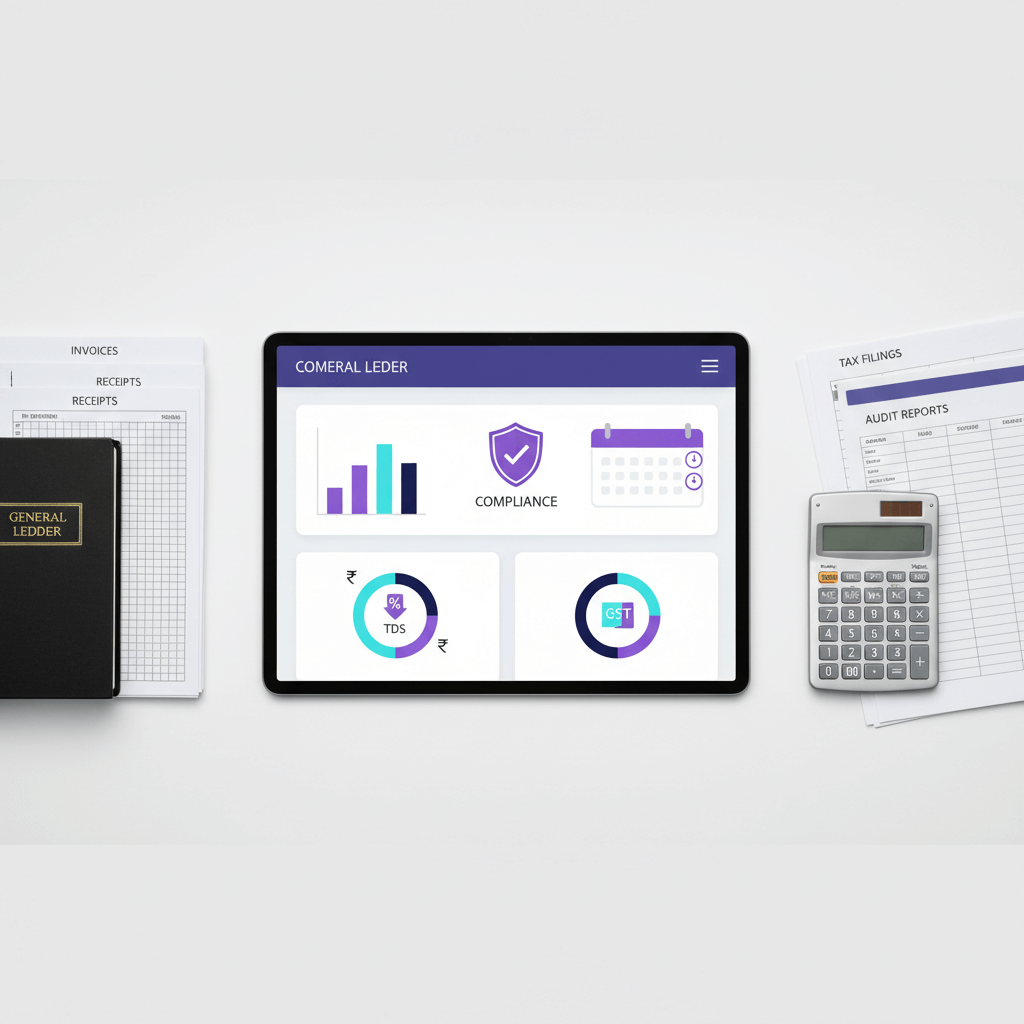Key takeaways
- Focused AR and AP dashboards turn late month chaos into clear actions, improving collections, payment prioritization, and working capital.
- Track the core trio: aging analysis, DSO, and Days Payable Outstanding (DPO), then layer collection efficiency and discount capture.
- Use visual playbooks, overdue heatmaps, vendor wise bars, and cash waterfalls to reveal where to act today, not next week.
- Integrate Tally or Zoho Books with Bank statements, GST, and GSTR 2B data to keep dashboards accurate and audit ready.
- Standardize follow ups via WhatsApp messages, phone escalations, credit holds, and an AP prioritization matrix for discounts and critical vendors.
- Automations and AI tools, for example AI Accountant, cut manual matching, handle TDS nuances, and surface risk so teams act faster.
- Measure ROI through DSO and DPO trends, discount capture rate, dispute reduction, and time saved in close, collections, and payments.
Table of contents
- What are AR and AP dashboard metrics
- Core AR dashboard metrics you need to track
- Essential AP dashboard metrics for cash management
- How to visualize overdue receivables effectively
- Building an effective vendor wise payable chart
- Reading monthly paid vs outstanding graph insights
- Understanding cash impact of overdue invoices
- Data sources and integration for Indian SMBs
- Implementation options for your dashboard
- Action playbooks based on dashboard insights
- Common pitfalls and how to avoid them
- Governance and review cadence
- Making your dashboard actionable
- Advanced analytics for growing SMBs
- Measuring dashboard ROI
- Conclusion
- FAQ
What Are AR and AP Dashboard Metrics
AR and AP dashboard metrics are the essential numbers that show you the health of your cash flow at a glance. Think of them as your financial pulse check, they tell you who owes you money, whom you owe, and when the cash crunch might hit.
These metrics go beyond simple outstanding amounts. They break down receivables and payables by age, highlight problem areas, and predict cash gaps before they become emergencies.
For Indian SMBs, juggling GST, TDS, and diverse terms, dashboards become the command center for smart, quick cash decisions.
Core AR Dashboard Metrics You Need to Track
Total receivables and aging analysis
Total receivables represent all unpaid customer invoices, net of credit notes. Real insight comes from aging the amount, splitting current versus overdue, and grouping into buckets such as 0–7, 8–15, 16–30, 31–60, 61–90, and over 90 days.
Days Sales Outstanding (DSO)
DSO shows how many days it takes on average to collect receivables, calculated as (Average AR ÷ Credit Sales) × 365. A 30–60 day band suits many Indian SMBs, manufacturing often runs longer, services should trend shorter.
Collection efficiency metrics
Collection efficiency measures what percentage of invoices due this month you actually collected, computed as cash collected this month ÷ invoices due this month. Declines signal weak credit controls or insufficient follow ups.
Essential AP Dashboard Metrics for Cash Management
Total payables and vendor analysis
Total payables include unpaid vendor bills, net of debit notes and returns. Track Days Payable Outstanding (DPO) as (Average AP ÷ Credit Purchases) × 365. Longer DPO boosts liquidity, but excessive delays strain vendor relationships. Monitor vendor concentration, if one vendor exceeds 30% of AP, that is concentration risk.
Strategic payment metrics
Track early payment discounts captured versus lost. Many suppliers offer 2–3% for paying within 7–10 days, which often outperforms bank yields. Monitor critical vendor exposure for must pay vendors like raw materials, utilities, and statutory dues.
How to Visualize Overdue Receivables Effectively
The best way to visualize overdue receivables is through complementary views that surface patterns and priorities.
Stacked column charts by aging
Use stacked columns by customer or branch, with segments for aging buckets transitioning from green to red as amounts get stale. This spotlights problematic accounts fast.
Customer aging heatmaps
Lay customers on rows and aging buckets on columns. Cell intensity shows outstanding amounts. You will quickly see repeat late payers or scatter patterns across buckets.
Pareto analysis for collection focus
Sort customers by overdue amount and overlay a cumulative percentage line to isolate the top 10–15 customers driving most of the overdue balance. Focus beats breadth. According to enterprise guidance, focused AR dashboards improve control and reduce credit risk by highlighting these concentration areas source.
Building an Effective Vendor Wise Payable Chart
A vendor wise payable chart should make prioritization obvious, not ornate.
Sorted bar chart structure
Use horizontal bars sorted by outstanding amount, color by aging buckets. Mark critical vendors whose delays disrupt operations. Surface terms, discount windows, and last payment date for context.
Information hierarchy
Answer, who do we owe the most, which invoices are overdue, where are we missing discounts. Group vendors into critical operations, routine supplies, and professional services to guide decisions when cash is tight.
Reading Monthly Paid vs Outstanding Graph Insights
The monthly paid versus outstanding view reveals seasonal patterns in cash flow.
Dual axis visualization
Show collections versus remaining receivables for AR, payments versus outstanding for AP, and overlay DSO, DPO trends. Rising DSO signals collection pressure, rising DPO can indicate constraints.
Cash flow overlay
Add net cash movement, collections minus payments, to find months that generate or consume working capital. Many Indian SMBs see Q4 inflows and Q1 usage. AR and AP aging charts improve visibility when combined with bank feeds for real time updates source.
Understanding Cash Impact of Overdue Invoices
Waterfall analysis
Start from opening cash, add expected collections, subtract slippage from overdue invoices, then deduct required outflows, especially statutory dues, to show projected surplus or shortfall.
Scenario planning
Model what if scenarios, collect top 10 overdues this week, or defer non critical payments by 10 days. This turns dashboards into planning tools, not just reports.
Risk assessment
Apply collection probabilities by aging bucket to estimate risk weighted cash inflows. For example, 0–30 days at 90%, over 90 days at 60%, for a realistic forecast.
Data Sources and Integration for Indian SMBs
Primary data sources
Tally and Zoho Books supply invoices, bills, credit and debit notes, receipts, and payments. Export masters to keep categories consistent. Bank statements in PDF, CSV, or Excel anchor the cash reality. GST and TDS references include e invoices, GSTR 1, GSTR 2B data, 26AS, and challans, ensuring tax aware aging.
Data processing requirements
Design invoice to receipt matching for exact and partial matches with tolerance for minor differences. Handle TDS gross up, treat invoices as paid for aging when customers deduct TDS, while tracking TDS receivable separately. Net credit notes against oldest linked invoices and flag unresolved notes for action.
Implementation Options for Your Dashboard
DIY Excel approach
Use Power Query to ingest exports and bank CSVs, then pivots and slicers for aging by party, branch, and rep. Build templates for AR aging, AP aging, collection trackers, discount capture, and cash waterfalls. Expect manual refresh.
Business intelligence tools
Power BI or Looker Studio with a star schema, invoice and payment fact tables, and dimension tables for parties, calendar, items, and tax codes. Add DAX measures for aging, DSO, DPO, collection efficiency, and discount capture. Create role based views for collectors, payables, and CFO summaries.
AI assisted automation
Tools like AI Accountant can automatically ingest bank statements and map them to ledgers, building AR and AP metrics with Indian compliance logic. One click sync with Tally and Zoho Books reduces cleanup and accelerates insights.
When choosing tools for receivables and payables, consider:
- AI Accountant — Automated bank statement processing with AR and AP aging dashboards for Indian SMBs, including GST and TDS handling
- QuickBooks — Cloud accounting with decent AR and AP tracking
- Xero — Clean invoicing and bill management
- Zoho Books — Comprehensive Indian compliance
- FreshBooks — Simple for service businesses
- Tally Prime — Local compliance mainstay
AP and AR KPIs guide better terms, discount capture, and efficiency when tracked and acted upon source.
Action Playbooks Based on Dashboard Insights
Overdue AR follow up process
Adopt a three tier cadence. Start with WhatsApp messages including statements and invoice links for 8–15 day overdues. Escalate to calls for 16–30 days, negotiate schedules. Apply credit holds beyond 30 days, and escalate top five overdues to founder level.
AP prioritization matrix
Pay critical vendors first. Capture early payment discounts when the annualized return beats your cost of capital, for example, 2% for 20 days early approximates a 36% annual return. Seek extended terms from non critical vendors during tight weeks.
Policy adjustments
Shorten terms for chronic late payers, or require advances and post dated cheques. Enforce purchase order and goods receipt note matching to reduce disputes. Prefer e invoicing on dispatch to start the clock earlier and improve DSO.
Common Pitfalls and How to Avoid Them
Data quality problems
Misapplied receipts inflate overdue amounts. Run unmatched receipt reports and add auto suggestion logic for matching. Apply advances automatically to oldest dues unless specified otherwise. Ensure credit notes link properly before approval.
Master data issues
Normalize party names, for example HUL and Hindustan Unilever Limited, to one master. Standardize credit terms and due date logic to keep aging consistent.
Process gaps
Prevent back dated postings after close with period locks. Separate FX gains and losses from core collection and payment metrics for clearer analysis.
Governance and Review Cadence
Team responsibilities
Assign clear owners for AR, AP, and CA reviews, with authority to act. Define escalation thresholds, for example, invoices over 1 lakh beyond 45 days, or a single vendor above 5 lakh payable.
Review rhythm
Weekly operations reviews should cover the top 20 overdue customers, payment promises, disputes, and AP critical payments and discounts. Month end CFO and founder reviews should track trends, policy effectiveness, and needed strategic shifts.
Alert thresholds
Trigger alerts when over 90 day receivables exceed 10% of AR, when any vendor crosses 30% of AP, or when projected cash shortfalls exceed your payroll buffer. Alerts should drive immediate action.
Making Your Dashboard Actionable
Drill down capabilities
Every high level tile should drill into invoice lists, contact details, and histories. Vendor summaries should link to terms, discount windows, and communications for payment decisions.
Mobile accessibility
Collectors and payables staff operate beyond desks. Provide mobile friendly views so field teams can call, confirm, and collect on the go.
Integration with communication tools
Create statements directly from aging views and vendor schedules from AP priorities. Consider WhatsApp for customer follow ups, a preferred channel for many Indian SMBs.
Advanced Analytics for Growing SMBs
Predictive cash flow
Predict future cash flows using historical collection curves, for example, 15% in week one, 60% in weeks two to four, 20% after day 30, and add seasonality and customer specific behaviors.
Customer risk scoring
Develop risk scores from payment history, aging patterns, disputes, and credit note rates. High risk customers may need advances or insurance. Monitor pattern shifts that hint at distress.
Vendor relationship optimization
Analyze payment timing to negotiate better terms, target discount capture, and repair strained relationships. Compare the value of discounts against alternative cash uses to optimize decisions.
Indian SMB focused, AI assisted dashboards can integrate Tally and Zoho, surface AR and AP aging gaps, and add scenario planning without dedicated data science source.
Measuring Dashboard ROI
Collection improvements
Track DSO reductions, for example, a drop from 50 to 40 days on 10 crore sales frees about 27 lakh in working capital. Monitor collection efficiency and bad debt provisions.
Payment optimization
Measure discount capture before and after AP dashboards. Fewer disputes and delays often translate into better vendor terms and service reliability.
Process efficiency
Quantify time saved in close, follow ups, and payments. Many teams cut manual reporting by 60–70%. Fewer emergency cash scrambles improve control and morale.
Conclusion
AR and AP dashboard metrics convert end month panic into proactive cash control. Start with aging, DSO and DPO, and cash impact waterfalls. Integrate clean data from Tally or Zoho Books, then institute weekly reviews with clear ownership.
As your setup matures, add predictive models, risk scores, mobile access, and communication hooks. The goal is not prettier charts, it is faster, better decisions that smooth cash and reduce stress.
Build in Excel, adopt BI, or use AI assisted platforms, just start now, iterate weekly, and stay anchored to actions that move collections and optimize payments.
FAQ
How should I compute DSO for Indian SMBs, given GST and TDS complications?
Use credit sales net of GST for the denominator so DSO reflects real commercial revenue. For the numerator, use average AR excluding GST ledgers. When customers deduct TDS, treat the invoice as fully paid for aging, and track the TDS receivable separately. Tools like AI Accountant automate TDS gross up and keep DSO accurate.
What DSO benchmark should a manufacturing SME in India target?
Typical manufacturing cycles sit between 45 and 75 days due to dealer networks and freight. Start by baselining your last 12 months, then aim to cut 10–15 days through stricter terms, early reminders, and better dispute closure. An AI Accountant style reminder cadence often delivers the first 5–8 days improvement quickly.
How do I treat advances and part payments in AR aging?
Apply advances to the oldest due invoices unless the contract specifies otherwise. For part payments, reduce the outstanding of the linked invoice and keep it in the appropriate bucket based on due date. Automations in AI Accountant can auto apply advances and propose best matches to prevent artificial overdues.
What is the cleanest way to calculate DPO when I have mixed cash and credit purchases?
Use credit purchases only, exclude cash buys, and compute DPO as Average AP divided by Credit Purchases times 365. Maintain separate ledgers for cash vendors to avoid inflating DPO. If your system tags terms, AI Accountant can segment purchases automatically.
How should TDS entries affect AR collections reporting?
When a customer deducts TDS, treat the commercial invoice as settled for aging and collection efficiency, move the deducted amount to TDS receivable. Reconcile TDS with 26AS monthly to keep the receivable clean. A rule based engine in AI Accountant can post these entries and match to challans.
What KPIs should I review weekly in a joint AR and AP standup?
Review top 20 overdue customers, promised dates versus actuals, collection efficiency for the month to date, critical vendor exposure, early discount capture rate, and projected 30 day cash position. Use a one page pack so decisions are immediate.
How do I reconcile vendor bills with GSTR-2B efficiently?
Match supplier GSTIN, invoice number, date, and taxable value to GSTR-2B, then flag mismatches for vendor follow up. Automate ingestion of GSTR 2B data and map to purchase registers. AI Accountant can auto reconcile and generate exception lists for your AP team.
What visualizations work best for founder level reviews?
Use a 3 by 3 board, overdue AR heatmap, vendor wise AP bars, and a monthly collections versus payments graph with DSO and DPO overlays. Add a cash waterfall to show likely surplus or shortfall. Keep drill downs one click away.
How do I quantify the ROI of AR automation to my management?
Translate DSO reduction into working capital freed, for example, 10 day improvement on 10 crore annual sales unlocks roughly 27 lakh. Add discount capture gains on AP, reduced bad debt provisions, and man hours saved in follow ups. AI Accountant implementations often pay back within a quarter in Indian SMBs.
What is a practical AR follow up cadence that does not alienate customers?
Send a friendly reminder 7 days before due, then on due date, then 7 and 15 days post due with statement links. Switch to a phone call after day 16, escalate at day 30 with a credit hold notice. Personalize tone for strategic accounts. AI Accountant can automate the schedule and log responses.
How should I prioritize AP when cash is tight in the last week of the month?
Pay statutory dues and critical vendors first, then capture high yield early discounts, then schedule the rest by risk of supply disruption and relationship importance. Use a vendor categorization matrix and show the cash impact of each choice in a waterfall. A scenario view in AI Accountant helps simulate options quickly.
What controls reduce disputes that slow collections?
Adopt three way match, PO to GRN to invoice, define acceptance SLAs, and share delivery proofs with e invoices early. Maintain a dispute register with owner and target closure date. Integrations and rules engines, as in AI Accountant, cut dispute aging materially.

-01%201.svg)



